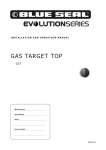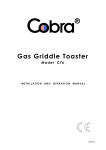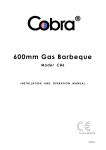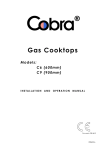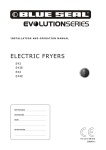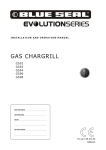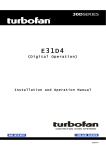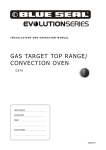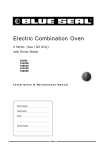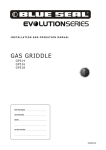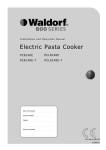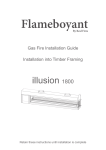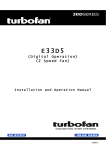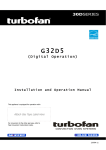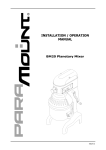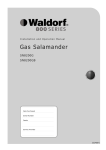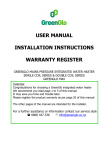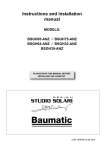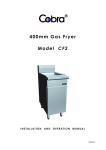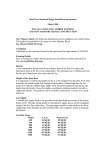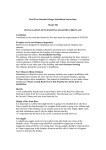Download User Manual - Comkit Online
Transcript
Gas Combination Oven S series - (Aus / NZ Only) with Direct Steam G9CSD G14CSD G20CSD G21CSD G40CSD Installation & Maintenance Manual Ref; 90023620 Rev 03 234862-2 INTERNATIONAL CONTACTS AUSTRALIA Moffat Pty Limited Web: E.Mail: Main Office: Service: Spares: Customer Service: www.moffat.com.au [email protected] (tel) +61 (03) 9518 3888 (fax) +61 (03 9518 3833 (tel): 1800 622 216 (tel): 1800 337 963 (tel): 1800 335 315 (fax): 1800 350 281 CANADA Serve Canada Web: E.Mail: Sales: Service: www.servecanada.com [email protected] (tel): 800 551 8795 (Toll Free) (tel): 800 263 1455 (Toll Free) NEW ZEALAND Moffat Limited Web: E.Mail: Main Office: www.moffat.co.nz [email protected] (tel): 0800 663328 UNITED KINGDOM Blue Seal Web: E.Mail: Sales: Spares: Service: www.blue-seal.co.uk [email protected] (tel): +44 121 327 5575 (fax): +44 121 327 9711 (tel): +44 121 322 6640 (fax): +44 121 327 9201 (tel): +44 121 322 6644 (fax): +44 121 327 6257 UNITED STATES Moffat Web: Sales: Service: www.moffat.com (tel): 800 551 8795 (Toll Free) (tel): +1 336 661 1556 (fax): +1 336 661 9546 (tel): 800 858 4477 (Toll Free) (tel): +1 336 661 1556 (fax): +1 336 661 1660 REST OF WORLD Moffat Limited Web: E.Mail: www.moffat.co.nz [email protected] The reproduction or copying of any part of this manual by any means whatsoever is strictly forbidden unless authorized previously in writing by the manufacturer. In line with policy to continually develop and improve its products, Moffat Ltd. reserves the right to change the specifications and design without prior notice. © Copyright Moffat Ltd. March 2011. 234862-2 CONTENTS Page 1. • INTRODUCTION 2 2. • SPECIFICATIONS 4 3. • INSTALLATION DIAGRAMS 5 4. • SPECIAL REQUIREMENTS FOR THE INSTALLATION SITE 11 5. • STATUTORY REQUIREMENTS AND TECHNICAL REGULATIONS 12 6. • POSITIONING 12 7. • ELECTRICAL CONNECTIONS AND EARTH BONDING 13 8. • POINTS TO REMEMBER WHEN MAKING THE ELECTRICAL CONNECTION 14 9. • WATER AND DRAIN CONNECTIONS 14 10. • VENTS 17 11. • GAS CONNECTION PROCEDURES 17 12. • OPERATING AT THE RATED HEAT OUTPUT 18 13. • COMMISSIONING AND TESTING 22 14. • IMPORTANT INFORMATION FOR THE USER 22 15. • MAINTENANCE 23 16. • GAS CONVERSION AND SPECIFICATIONS 23 • NOTES 26 MODELS G9CSD G14CSD G20CSD G21CSD G40CSD - Gas Combination Oven, - Gas Combination Oven, - Gas Combination Oven, - Gas Combination Oven, - Gas Combination Oven, 9 of 1/1 GN Trays. 14 of 1/1 GN Trays. 20 of 1/1 or 10 of 2/1 GN Trays. 20 of 1/1 GN Trays. 40 of 1/1 or 20 of 2/1 GN Trays. VERSIONS S - Programmable electronics with direct access key to the programs and recipes, automatic humidity control and lighting. The manufacturer accepts no liability for any inaccuracies in this manual attributable to printing or copying errors. We reserve the right to modify our products as we deem fit, without impairing their basic features. The reproduction or copying of any part of this manual by any means whatsoever is strictly forbidden unless authorized previously in writing by the manufacturer. 15.09.2008 234862-2 1 1. INTRODUCTION We are confident that you will be delighted with your Blue Seal Combi Oven, and it will become a most valued appliance in your commercial kitchen. To ensure you receive the utmost benefit from your new Blue Seal appliance, there are two important things you can do. Firstly Please read the instruction book carefully and follow the directions given. The time taken will be well spent. Secondly If you are unsure of any aspect of the installation, instructions or performance of your appliance, contact you BLUE SEAL dealer promptly. In many cases, a phone call could answer your questions. WARNING: INSTRUCTIONS TO BE FOLLOWED IN THE EVENT THE USER SMELLS GAS ARE TO BE POSTED IN A PROMINENT LOCATION. THIS INFORMATION SHALL BE OBTAINED BY CONSULTING THE LOCAL GAS SUPPLIER. WARNING: GREAT CARE MUST BE TAKEN BY THE OPERATOR TO USE THE EQUIPMENT SAFELY TO GUARD IT AGAINST RISK OF FIRE. • • THE APPLIANCE MUST NOT BE LEFT ON UNATTENDED. IT IS RECOMMENDED THAT A REGULAR INSPECTION IS MADE BY A QUALIFIED SERVICE PERSON TO ENSURE CORRECT AND SAFE OPERATION OF YOUR APPLIANCE IS MAINTAINED. WARNING: DO NOT STORE OR USE GASOLINE OR OTHER FLAMMABLE VAPOURS OR LIQUIDS IN THE VICINITY OF THIS OR ANY OTHER APPLIANCE. DO NOT SPRAY AEROSOLS IN THE VICINITY OF THIS APPLIANCE WHILE IT IS IN OPERATION WARNING: IMPROPER INSTALLATION, ADJUSTMENT, ALTERATION, SERVICE OR MAINTENANCE CAN CAUSE PROPERTY DAMAGE, INJURY OR DEATH. READ THE INSTALLATION, OPERATING AND MAINTENANCE INSTRUCTIONS THOROUGHLY BEFORE INSTALLING OR SERVICING THIS APPLIANCE . C AUTIO N : This appliance is for professional use and is only to be used by qualified people 234862-2 2 1. INTRODUCTION Installations must be carried out by qualified persons only. Failure to install equipment to the relevant codes and manufacturer’s specifications shown in this section will void the warranty. 1.8 Components having adjustments protected (e.g. paint sealed) by manufacturer are only allowed to be adjusted by an authorised service agent. They are not to be adjusted by the installation person. 1.1 The oven must be installed, commissioned and maintained only by a Blue Seal authorized service agent. 1.2 Carefully read the directions given in this manual; they contain important information on safety during installation, operation and maintenance. Keep this manual in a safe place for future consultation! AM X E 1.9 This appliance is for professional use and is only to be used by qualified personnel. 1.4 1.6 Packing materials must be disposed of in conformity with local regulations. This normally means that the different materials are sorted according to type and collected as urban refuse. 1.7 Before positioning and connecting the appliance, check that the utilities (electrical power, water and gas supplies) are as indicated on the data plate. The data plate is on the right-hand side, at the bottom. The positions of the inlet and drain connections are clearly labelled. For further details, see the installation diagram attached to this manual. 1.11 During installation and / or maintenance work it is recommended you wear gloves to protect your hands. Having removed the packing check that the appliance is not damaged in any way. If in doubt, proceed no further with installation of the appliance and contact the Blue Seal Customer Service or your dealer immediately. Packing materials are potentially dangerous and must not be left where children can play with them. O NOTE: If for some reason it is not possible to get the appliance to operate correctly, shut off the gas supply and contact the supplier of this unit. This appliance must be put only to the use for which it is specifically intended, i.e. cooking foods; any other type of use is improper and therefore dangerous. 1.5 E PL Y NL 1.10 In the event of breakdown or faulty operation, switch off the oven immediately! C AUTIO N : 1.3 Example of a data plate:- 1.12 Safety sticker • Maximum height for inserting containers with liquids. 234862-2 3 2. SPECIFICATIONS TABLE 1: GAS DATA Model Consumption Rate [MJ/hr] Supply Pressure G9CSD Nat Gas 38 MJ/hr LPG (Propane) G14CSD G20CSD 71 MJ/hr 100 MJ/hr Nat Gas 1.13 - 5.0 kPa LPG (Propane) 2.75 - 6.0 kPa G21CSD G40CSD 120 MJ/hr 200 MJ/hr See Note 1. Burner Operating Pressure Gas Connection R ½” R ¾” NOTE: 1. Gas burner operating pressure (regulator outlet) is ex-factory set for atmospheric pressure and it is not to be adjusted. TABLE 2: ELECTRICAL DATA Supply Voltage Frequency Electrical Power Input Motor Supply Cable (Oil-Proof) 230-240 V ac 50 Hz 0.5 kW 1 x 0.25 kW 3 x 1mm2 (10A) 230-240 V ac 50 Hz 1.0 kW 1 x 0.55 kW 3 x 1mm2 (10A) G20CSD 230-240 V ac 50 Hz 1.0 kW 1 x 0.55 kW 3 x 1mm2 (10A) G21CSD 230-240 V ac 50 Hz 1.8 kW 2 x 0.55 kW 3 x 1mm2 (10A) G40CSD 230-240 V ac 50 Hz 1.8 kW 2 x 0.55 kW 3 x 1mm2 (10A) Model G9CSD G14CSD TABLE 3: GENERAL WATER DATA Water Pressure [kPa] Softened Water Consumption [max.l/h] 200 - 500 15 2 x R ¾" (1) 200 - 500 22 2 x R ¾" (1) G20CSD 200 - 500 22 2 x R ¾" (1) G21CSD 200 - 500 30 2 x R ¾" (1) G40CSD 200 - 500 44 2 x R ¾" (1) Model G9CSD G14CSD (1) Water Connection The ovens are equipped with two water inlets, one for non-softened cold water and the other for hot water (max. 50 °C) or softened cold water. 234862-2 4 3. INSTALLATION DIAGRAMS G9CSD- Dimensions 234862-2 5 3. INSTALLATION DIAGRAMS G14CSD - Dimensions 234862-2 6 3. INSTALLATION DIAGRAMS G20CSD - Dimensions 234862-2 7 3. INSTALLATION DIAGRAMS G21CSD- Dimensions 234862-2 8 3. INSTALLATION DIAGRAMS G40CSD- Dimensions 234862-2 9 3. INSTALLATION DIAGRAMS DISTANCES TO OBSERVE We recommend keeping a distance of 500mm (20”) on the right-hand side in order to carry out maintenance work. DO NOT INSTALL APPLIANCES WITH A SOURCE OF HEAT ON THE RIGHTHAND SIDE OF THE OVEN. C AUTIO N : If the ambient temperature to the right of the appliance is too high, the oven will stop for safety reasons. Minimum distance from sources of heat on the right-hand side: 400mm (15.7”). 234862-2 10 4. SPECIAL REQUIREMENTS FOR THE INSTALLATION SITE Installation Requirements NOTE: • It is most important that this appliance is installed correctly and that operation is correct before use. Installation shall comply with local electrical, gas, health and safety requirements. • This appliance shall be installed with sufficient ventilation to prevent the occurrence of unacceptable concentrations of health harmful substances in the room, the appliance is installed in. This appliance is designed to provide years of satisfactory service, and correct installation is essential to achieve the best performance, efficiency and trouble-free operation. It must be installed in accordance with applicable National and Local installation gas, electrical and fire safety codes / regulations. AUSTRALIA: NEW ZEALAND: Australia / New Zealand: - AS5601 - NZS5261 - AS / NZS3000 - AS / NZS3500 - Gas Installations. - Gas Installation. - Wiring Rules. - Plumbing and Drainage Code. Installations must be carried out by qualified persons only. Failure to install equipment to the relevant codes and manufacturer’s specifications shown in this section will void the warranty. Components having adjustments protected (e.g. paint sealed) by the manufacturer are only allowed to be adjusted by an authorised service agent. They are not to be adjusted by the installation person. The manufacturer accepts no liability for any damage or malfunctioning of the appliance attributable to the absence or inadequacy of earthing systems, to the incorrect arrangement or installation of auxiliary systems, also to incorrectly made connections or to non-compliance of the building's electrical system with current regulations. 4.1 The room where the oven is to be fitted has to be well ventilated with all the openings required for rooms with gas installations (Refer to specific regulations). NOTE: It is important that adequately sized piping runs directly to the connection joint on the appliance, with as few tees and elbows as possible to give maximum supply volume. 4.2 Current accident prevention guidelines; 4.5 4.3 The oven needs a water supply, incorporating a softener with suitable flow and pressure specifications (see Section 2 “Specifications” and Section 9 “Water and Drain Connections”). A shutoff valve must be installed on each of the water supply pipelines to the appliance. 4.4 The room must have a water drain in a good position for the oven to be installed, its specifications are given under Section 8 “Water and Drain Connections” in this manual. The gas supply plumbing must be installed in accordance with current regulations, adopting pipe sections and pressures suitable for the appliance (see Section 2 “Specifications” and Section 11 “Gas Connections Procedures”). A fast acting shutoff valve must be installed on the gas inlet line to the appliance. It is absolutely essential that this valve should be specified to current standards and type test approved. 4.6 The electrical isolating switch and the water and gas shutoff valves must all be located near to the appliance, within easy reach for the user. 234862-2 11 5. STATUTORY REQUIREMENTS, TECHNICAL REGULATIONS AND DIRECTIVES Throughout installation it is vital to observe the following requirements: 5.1 Any health and hygiene standards applicable to kitchens and eating places; 5.2 Local and/or territorial building regulations and fire prevention standards. 5.3 Current accident prevention guidelines; 5.4 5.5 The regulations of the electrical power supply company or agency; Any other local regulations. 6. POSITIONING 6.1 To position the appliances, it is recommended to use the mount offered by the manufacturer; should you want to do things differently, it is necessary to take account of the weight of the appliance. 6.2 Before manoeuvring the oven into the selected position, attach the water inlet hoses and waste pipe to the relative connection points (See Section 9 “Water and Drain Connections”). 6.3 The distances from other appliances or from adjacent walls that must be left to allow access for servicing operations will be found on the installation diagram for the oven to connect. In the event of the oven being installed directly against an inflammable wall, suitable heat insulation must be provided. Current fire regulations should be meticulously observed and respected. Do not obstruct the openings and slots in the casing as they disperse the heat in the electric component compartment. Keep strictly to the installation diagrams. 6.4 Once the appliance is installed, the electrical power cable must be protected, and never stretched or tugged. 6.5 The appliance must be level: any difference in level or sloping of the supporting surface should be eliminated. Differences in level or sloping negatively affect oven operation. 6.6 Remove all packing materials and peel away the protective plastic film from all external surfaces of the oven. 6.7 234862-2 12 For free-standing models, the appliance needs to be levelled: small differences in level of the supporting surface can be eliminated with the adjustable feet (by screwing or unscrewing them). A significantly uneven or sloping stance can affect the operation of the oven adversely. For models equipped with a pan trolley, it is necessary to pay special attention when levelling. 6. POSITIONING 6.8 Lining up the pan trolleys G20CSD and G21CSD. If the floor is not level, a remedy must be found using an access ramp with a maximum gradient of 4° (not included in the supply). If there is an outlet grate in front of the appliance, it is necessary to fit runners in the pan trolley entry area. 7. ELECTRICAL CONNECTIONS AND EARTH BONDING NOTE: All electrical connection must only be carried out by a qualified electrical service person. 7.1 7.2 7.3 As this oven is supplied without a power cable and plug, the cable and other hardware needed to make the connection to the electrical power supply must be provided by the installer. The cable must satisfy the requirements indicated in Table 1 'Electrical Data'. The oven must be connected to the power supply by way of a multiple pole main isolating switch ensuring a gap between open contacts of at least 3mm on each pole. The cable must be fed in from beneath the clamp. The individual wires are then fastened to the corresponding terminals of the terminal board. The earth wire must be longer than the other wires, so that in the event of the cable being jerked or the clamp broken, the live wires will disconnect first. Check the efficiency of the isolating switch The oven must be kept in an equipotential system. This connection is made by wiring a conductor of nominal cross section 10mm2 to the corresponding terminal at the back of the oven, which is marked with the internationally recognized symbol. All appliances in the room are bonded in this way and connected to the earth system of the building. To gain access to the AC mains connection terminal board, the right hand panel of the casing must be removed by undoing the fixing screws (all models). 7.4 234862-2 13 The electrical safety of this appliance can be guaranteed only when it is connected correctly to an efficient earth system, in compliance with current standards. 8. POINTS TO REMEMBER WHEN MAKING THE ELECTRICAL CONNECTION 8.1 As all ovens of the series are fitted with an alternating fan motor (clockwise and anticlockwise rotation), there is no need for the fan to rotate in any particular direction. Simply verify, when commissioning the appliance, that the fan is balanced and rotates freely. 8.3 This problem is indicated by:On gas models mechanical version by the burner ignition reset button, which is lit up. On gas models electronic version via the electronic card. 8.4 Check also that the neutral registers zero potential when tested. If not, the fault already described in Item 8.3 of this section will occur. In this eventuality, consult the installer of the building's electrical system. C AUTIO N : The G21CSD and G40CSD models are equipped with two motors. 8.2 When making the electrical connection, care is needed to ensure that the neutral pin of the terminal block corresponds to the neutral wire of the supply line. If this connection is not made correctly, the burners will not operate correctly. 9. WATER AND DRAIN CONNECTIONS Australia / New Zealand only: Water installation must be done in compliance with AS/NZS 3500 Plumbing and Drainage Code. 9.2 The water connection is R 3/4”. Australia only: Double Check Valve supplied with this appliance must be installed in the water supply line to this appliance to provide total backflow prevention required by Plumbing Code of Australia. This valve must be installed on upstream of any water filtering or conditioning device installed in association with this appliance, i.e. before the water supply line separation into the separate inlet water connections (A) and (B) of this appliance. 9.1 WATER CONNECTIONS The water supplied must be either cold and softened or hot (max 50 °C), as described below. The hose for connection to the water supply must be provided by the installer. A shutoff valve must be installed in the line between the oven and the mains supply. 9.3 WATER SPECIFICATIONS The characteristics of the water must be within the limits given below, in order to prevent corrosion, which is extremely damaging for the appliance, due to supplying water that is too softened or too aggressive, and scaling in the oven and in the water system due to water that is too hard. Hardness: between 3° and 6° TH. PH: greater than 7.5. Chlorides: less than 30 ppm. WATER PRESSURE The pressure of the water in the network must be between 200 and 500 kPa, as already stated under the Section 2 'Specifications'. If the supply pressure is higher than this, a pressure reduction valve must be installed between the oven and the These values are important for ensuring that the water used by the appliance is suitably treated. 234862-2 14 9. WATER AND DRAIN CONNECTIONS 9.4 WATER CONNECTIONS FOR CONDENSING STEAM The water used for condensing steam need not be softened, but must be cold. The water connection is R 3/4. The hose for connecting to the water supply must be provided by the installer. A shutoff valve must be installed in the line between the oven and the mains supply. 9.5 DRAINING The water is drained off by gravity through a heat-resistant pipe DN 50 (not flexible), maximum length 2m, installed at an angle of no less than 4°. Mean temperature of the drain water: 65°C. For the range with the drain as per Fig 1, it is possible to make a direct connection with an air trap, without fitting a drain cup, as the drainage manifold system has an internal air drop (Fig. 2). With a drain on the floor without an air trap, it is necessary to have an outlet clearance of 2cm (Fig. 3). For the remaining models, it is imperative to fit a tundish to ensure a minimum air drop of 25mm. between the appliance's plastic drain elbow and drain line. A direct connection is not permissible. C AUTIO N : The drain line must be outside the perimeter of the oven. It is prohibited to reduce the drain diameter. 234862-2 15 9. WATER AND DRAIN CONNECTIONS 9.6 FITTING THE HAND SHOWER NOTE: To fit the shower attachment, the oven RH side panel must be removed. Do NOT attempt to fit the hand shower attachment without removing the side panel as electrical equipment behind the panel can get damaged and there is potential for causing electric shock. Ensure electrical power is disconnected before commencing. 5. Ensure that the water supply is turned off at the mains shut-off valve. 6. Connect up the hose connection from the shower head to the ‘T’ connection at the rear of the oven. The oven is supplied with a hand shower attachment which must be fitted to the oven as part of the installation process. NOTE: Ensure that the supplied sealing washers are fitted between the ‘Tee’, Hose and Hand Shower. To fit the hand shower attachment, the right hand side panel of the oven must be removed to drill and attach the hand shower mounting bracket. To fit the hand shower attachment, carry out the following operation:1. Remove the 3 screws securing the right hand side panel (as viewed from front of oven). 7. Fit the shower head to the shower head mounting bracket. Oven R/H Side Panel 8. Turn ‘On’ the water supply and check for leaks. 9. Carry out a functional check of the shower head. Remove 3 Screws 60 mm 2. Drill a 5.5 mm hole in the top left hand corner of the side panel as shown on the diagram below. Oven R/H Side Panel 60 mm Connect Shower Head Hose Connection Here. 3. Secure the shower head mounting bracket to the side panel with the bolt, nut and washers supplied. Mounting Bracket Reverse Side of Panel 4. Refit the side panel to the oven and secure with 3 screws. 234862-2 16 Mounting Bracket Shower Head 10. VENTS 10.1 Under no circumstances must vents A and B be shut, blocked or ducted into other pipes. A - Vent to extract vapours from the oven. B - Safety vent. 11. GAS CONNECTION PROCEDURES NOTE: Do not obstruct or block the appliances flue. Never directly connect a ventilation system to the appliance flue outlet. Installation Requirements NOTE: This appliance shall be installed with sufficient ventilation to prevent the occurrence of unacceptable concentrations of health harmful substances in the room, the appliance is installed in. WARNING: FLUE GASES MAY REACH TEMPERATURES OF 400°C. FLUE 11.1 GAS CONNECTION GASES MUST NEVER BE DUCTED AWAY UTILIZING AN EXTRACTION SYSTEM. NOTE: All gas fitting must only be carried out by a qualified gas service person. CLEAR THE GAS SUPPLY SYSTEM OF ANY MACHINING DEBRIS BEFORE CONNECTING UP THE OVEN. The section of the gas supply pipe must be chosen according to the type of gas and the consumption of the appliance to be connected. The system must be designed and installed in accordance with current regulations. 11.2 LEAK TEST WARNING: DO NOT USE A NAKED FLAME TO CHECK FOR GAS LEAKAGES. The gas connection on the oven is either R 1/2” or R 3/4”, and this section must never be reduced. All connections between the mains and the appliance must be tested for leakage. The recommended method is to use a proprietary leak detection spray; alternatively, a noncorrosive foamy liquid of any general description can simply be brushed onto the fittings: whichever method is used, no bubbles should appear. A fast acting shutoff valve must be installed on the gas inlet line to the oven. The valve must be type test approved in accordance with current regulations. A suitable joining compound which resists the breakdown action of LPG must be used on every gas line connection, unless compression fittings are used. The manufacturer accepts no liability for any damage or malfunctioning of the appliance attributable to the absence or inadequacy of earthing systems, to the incorrect arrangement or installation of auxiliary systems, also to incorrectly made connections or to non-compliance of the building's electrical system with current regulations. 234862-2 17 12. OPERATING AT THE RATED HEAT OUTPUT 12.4 MEASURING THE SUPPLY PRESSURE The inlet pressure is measured using a manometer connected to the supply pressure test point (B) of the gas control valve. To gain access to the valve, remove the right-hand side casing panel. Before connecting the manometer, loosen the screw sealing the supply pressure test point (B). Now measure the pressure with the burner in operation. The value shown on the manometer must come within the limits given in Section 2 ‘Specifications’, ‘Table 1: Gas Data’. After checking, carefully close the supply pressure test point (Screw B). The sealed screws on the valves must never be tampered with under any circumstances. WARNING: THE GAS SYSTEM COMPONENTS ARE FITTED FOR A 6.0 KPA. HIGHER SUPPLY PRESSURES ARE NOT PERMISSIBLE. MAXIMUM PRESSURE OF 12.1 During final testing in the factory, all appliances are fitted for the type of gas shown on the sticker next to the rating plate. Should the appliance fitting not correspond to the gas type available on location, the appliance must be converted to adapt to the type of gas available. Refer to the Gas Conversion Section. 12.2 Commissioning of the appliance to operate at the rated heat output is dependent on the inlet pressure, calorific value of the gas and the correct amount of primary air. 12.3 The inlet pressure required for the appliance to operate with the various types of gas typically available will be within the limits indicated in Section 2 'Specifications', 'Table 1: Gas Data'. The appliance must not be commissioned if inlet pressure values are outside these limits. If pressures differ from those indicated in Table 1, the gas supply company or agency should be contacted, or alternatively the contractor by which the system was installed in the building. Gas Mix Rate B - Supply Pressure Test Point NOTE: Mix screw and burner operating pressure are ex-factory fixed and further adjustment is not provided nor required. If for some reason it is not possible to get the appliance to operate correctly, shut off the gas supply and contact the supplier of this unit. 234862-2 18 12. OPERATING AT THE RATED HEAT OUTPUT CHECKING NOMINAL HEAT CAPACITY S VERSION - Chamber Burner Check the depth of the screw “A” in accordance with table 5 of the “Tecnical gas data” booklet, using a gauge. Check that the burner fan speed, corresponds to the data given in table 5 of the “Technical gas data” booklet. To enter the management screen of the burner to Check : With the appliance live and display off, press button 1,the display 2 shows [USb], turn knob 3 until [rEL] is displayed, press the knob to confirm the selection Turn knob until [123] (access password for parameter modification) and confirm by pressing knob 3 234862-2 19 12. OPERATING AT THE RATED HEAT OUTPUT 1 2 3 4 5 Turn knob 5 until [br1] on display 7 and confirm by pressing knob 3. Display 2 shows parameter [151] IGN ignition speed and display 4 shows the ignition speed value (example [110]). To modify the value press knob 5, turn to knob 5 to set the new value and confirm by pressing knob 5. Turning knob 3 takes us to display 2 and visualisation of parameter [152] minimum speed, and display 4 shows the minimum speed value (example [136]). Turning knob 3 again takes us to display 2 and visualisation of parameter [153] maximum speed, and display 4 shows the maximum speed value (example [173]). Press button 1 to select another burner by turning knob 5. Proceed in the same way to check the values of the other burners if present (example [br2]). 234862-2 20 12. OPERATING AT THE RATED HEAT OUTPUT 1 6 2 3 4 5 Then, to test the correct functioning of the burners, exit the screen by pressing 1. During testing, it is possible to manually block the sequence by pressing button 1; this way, the burner blocks in the desired phase (ex. IGN ignition) allowing the technician to carry out other verifications in this phase. To test chamber burner [br1], turn scroller 5 until [br1] on display 2, and then start-up the cycle with the 6 “START/STOP”button. When a phase is blocked, the point indicating phase 1, 2 or 3 flashes. The burner will go in pre-ventilation to then pass on to the set IGN ignition. The first IGN ignition stage is indicated on display 4, by the first point under the speed value. To restart the sequence, always press button 1. NOTE: in case of maximum speed, the cycle block becomes pointless since the oven is already working normally; it is possible to shift to minimum phase by pressing key 1. Then, the minimum and maximum speed stages, indicated respectively in the second and third points, will automatically activate. To carry out the tests with the door open, once the cycle is started, press the “CLIMA” button; this function is useful during combustion analysis and for functioning tests of the prolonged burner without reaching the temperature previously set in the chamber The correct burner functioning is highlighted by the increase of the temperature in the cooking compartment. Once reached a speed stage, press button 1 to shift to the previous stage. To deactivate burner functioning, press button 6 “START/STOP” again. To exit the cycle press button 1. NOTE: To check/adjust the boiler burner, activate the Boiler Burner section (example [br2]) as operated for cooking compartment burner heating 234862-2 21 13. COMMISSIONING AND TESTING 13.3 You should moreover check that the silicone joints and sleeves of the water circuit (oven vent, oven outlet, drip tray) do not leak. 13.1 Check the appliance and the entire installation as soon as connection has been completed. 13.4 Carefully refit the right-hand side that was removed for the above work. Check in particular: • That there are no traces of the protective film on the outside walls and that the oven is empty; • All vents are clear; • The connections are made as required and instructed in this handbook; • All the safety requirements of the current standards, laws and directives are met; • There is no leakage from the gas and water connections; • Water drainage and flue gas extraction are clear. 13.5 For an additional check that the appliance is operating correctly, carry out a volumetric measurement of the quality of gas consumed. The meter will show how much gas has been consumed over a given period of time, and this value can be checked against the values given in Section 2 'Specifications', Table 1 “Gas Data". 13.6 The test report must be completed in full and submitted to the customer, who should then sign in acceptance. With effect from this moment, the appliance is covered by the manufacturer’s warranty. 13.2 Now proceed to light the oven as directed in the 'User Operating Manual', checking the smooth ignition of the burner. 14. IMPORTANT INFORMATION FOR THE USER 14.4 Keep the installation manual and the wiring diagram for future reference. Explain to the user that the user manual supplied with the oven must be kept near the oven in a place where it can be seen. It is good policy to make a note, in the user manual, of the name and contact numbers of the selected Service Agent. 14.1 With the user manual to hand, show the user the functions, safety devices, appropriate use and, above all, the time intervals for servicing the oven. Maintenance operations include cleaning the burners, inspecting the combustion chamber and cleaning the various ducts and pipes, and should be carried out at least once a year. Customers are recommended to sign a service agreement. 14.5 Explain to the user that certain faults in operation are often due to simple errors or oversights such as failure to switch on or connect utilities. Accordingly, kitchen staff should be trained in such a way that they can use the appliance confidently and understand how it operates. Faults of a recurring or persistent nature must be investigated by a Blue Seal authorized Service Agent. 14.2 Ensure the user is fully aware that such repair and / or maintenance operations as may become necessary over time must be carried out only by a Blue Seal authorized service agent. 14.3 Explain clearly to the user that in the event of breakdown or faulty operation, all connected utilities (water, electricity and gas) should be shut off immediately. 14.6 Explain clearly that any alterations to the room or changes in ventilation may affect the operation of gas-fired appliances. In these cases, it is advisable to have the oven functions checked over. 234862-2 22 15 MAINTENANCE 15.1 MAINTENANCE PROCEDURE Every 6 months the burner air supply inlet located behind the service panel should be inspected and cleared of any build up of material to ensure an un-obstructed air supply to the burners. 1. Carefully pull out the burner air supply pipe from the air inlet elbow (this is a push fit). 2. Clean out the pipe ensuring that there are no blockages. 3. Refit the burner air supply inlet to the air inlet elbow. Air Inlet Elbow Burner Air Supply Inlet Fig 1 16. GAS CONVERSION AND SPECIFICATIONS 16.1 GAS CONVERSION PROCEDURE 1. Turn off the electrical and gas supplies to the appliance at the mains supply. 2. Remove the right hand side panel from the appliance by removing the 2 screws from the lower edge of the panel and remove the side panel. 3. Carefully pull off the inlet elbow from the end of the blower. (Refer to Fig 2). C AUTIO N : Ensure that the Unit is isolated from the gas supply before commencing servicing. NOTE: • These conversions should only be carried out by qualified persons. All connections must be checked for leaks before re-commissioning the appliance. • For all relevant gas specifications refer to the table at the end of this section. Air Inlet Elbow Gas appliances are commissioned as standard to run on Natural Gas. Requests for commissioning for different types of gas (e.g. LPG) must be made at the time of ordering, or use the conversion kit included with the appliance. It is important that the correct gas orifice disc is fitted for the gas type the unit is going to be used on. Refer to the table at the rear of this section for gas specification details. This disc, which acts as a gas duct diameter reducer, must be fitted at the gas valve outlet, as shown overleaf. Fig 2 4. Unscrew and remove the 3 screws at the rear of the gas valve, ensuring that the allen key is no longer than 100mm (for access purposes). Gas Valve Mounting Screws 234862-2 23 Fig 3 17. GAS CONVERSION AND SPECIFICATIONS 5. Remove the black rubber gasket fitted to the gas valve outlet (Refer to Fig 4) and replace the brass disc inside the gasket with the correct orifice size specified in the 'Gas Specifications Data' table at the rear of this section. Disc 6. Check that the central orifice is free from burrs that could cause turbulence when the gas passes through it. Rubber Gasket Fig 4 7. Position the gasket / disc assembly into the gas valve outlet, making sure that it fits snugly around the full perimeter of the valve outlet. (Refer to Fig 4). 8. Refit the gas valve to the rear of the blower and secure in place with the 3 screws. (Refer to Fig 3 on previous page). NOTE: Ensure that all wiring connections to the gas valve and ignition module remain intact, especially the burner flame sensor wire connection. Ensure that the Burner Flame Sensor Wire is not Damaged or Broken 17.2 GAS MIXING SCREW Gas Mix Screw is ex-factory set at 10mm depth and it is not to be adjusted. 17.3 BURNER BLOWER SPEED ADJUSTMENT Adjust the Burner Blower Speed as shown in Section 12.5 'Checking Nominal Gas Input Rate', sub section 'Burner Blower Speed'. 234862-2 24 Fig 5 17. GAS CONVERSION AND SPECIFICATIONS GAS SPECIFICATIONS Model Consumption Rate [MJ/hr] Gas Flow Orifice [mm] Mix Screw [mm] (See Note 1) G9CSD G14CSD G20CSD G21CSD G40CSD 38 71 100 120 200 Nat Gas Ø 4.40 Ø 5.40 Ø 5.40 Ø 5.40 Ø 5.40 LPG (Propane) Ø 2.90 Ø 3.90 Ø 4.10 Ø 3.90 Ø 4.10 Butane Ø 2.80 Ø 3.70 Ø 3.80 Ø 3.70 Ø 3.80 Nat Gas 10 10 10 10 10 LPG (Propane) Butane 10 10 10 10 10 Ign 110 110 110 110 110 Min 135 140 140 140 140 Max 175 175 190 175 190 Ign 110 110 110 110 110 Min 135 140 140 140 140 Max 185 175 185 175 185 Nat Gas LPG (Propane) Nat Gas Burner Fan Speed [Hz] LPG (Propane) Butane Supply Pressure Nat Gas 1.13 - 5.0 kPa LPG 2.75 - 6.0 kPa See Note 2. Burner Operating Pressure Gas Connection NOTE: 1. 2. R ½” R ¾” Mix screw is ex-factory set to 10 mm (± 1.0) depth and it is not to be adjusted. Gas burner operating pressure (regulator outlet) is ex-factory set for atmospheric pressure and it is not to be adjusted. 234862-2 25 NOTES Check the combustion, CO (ppm) and CO2 (%)values, with an appropriate instrument: Start the oven working, 180°C convection mode, open the door and short the micro-door with a magnet fixed with tape, the oven restarts and wait for approximately 5 minutes. Position the flue gas collection probe in the flue gas outlet pipe (chamber and boiler). The CO2 must b 234862-2 26





























